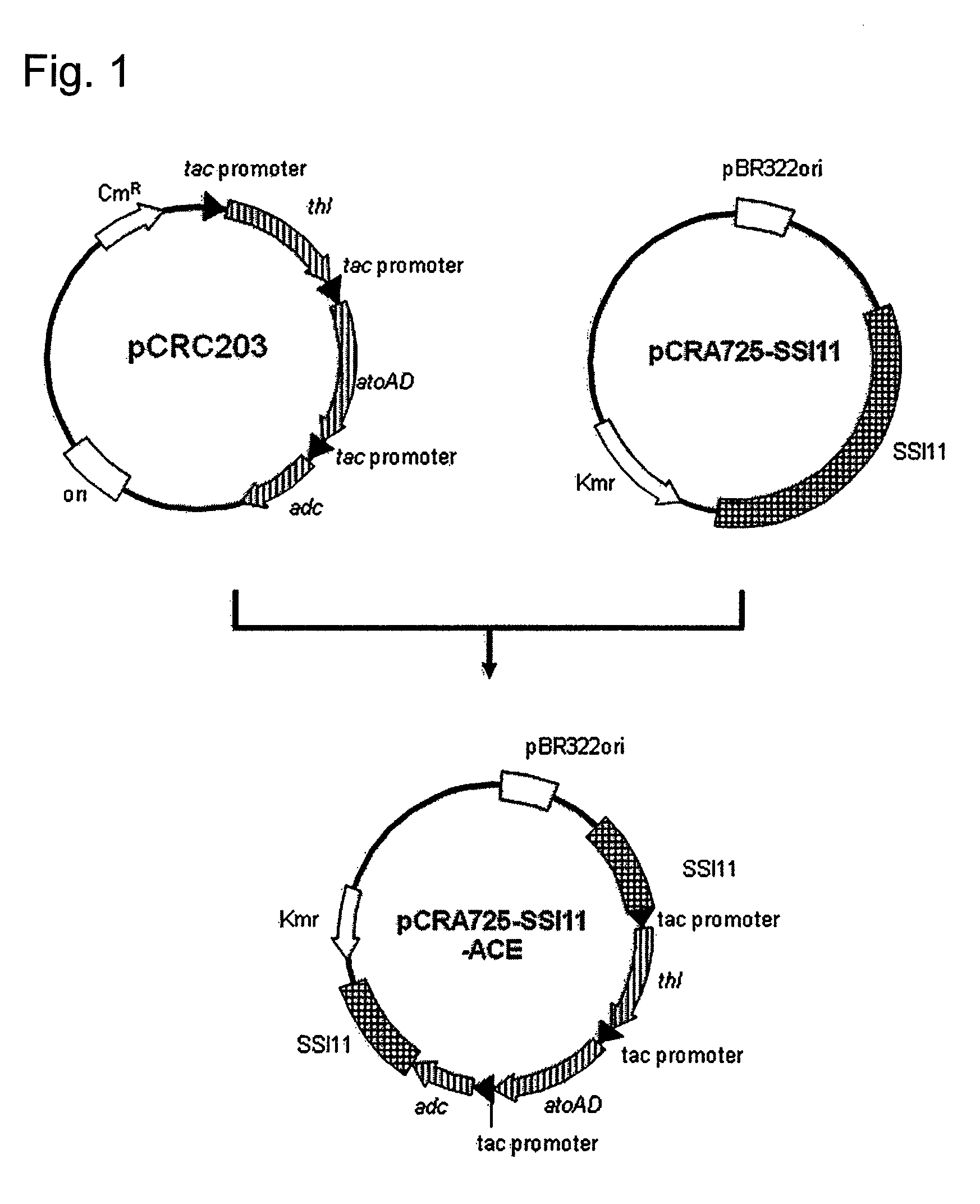Transformant of coryneform bacteria capable of producing isopropanol
a coryneform bacterium and transformant technology, applied in the direction of microorganisms, biochemical equipment and processes, bacteria based processes, etc., can solve the problems of low isopropanol production rate, low proliferation rate, low isopropanol production efficiency, etc., to achieve efficient isopropanol production and efficient production
- Summary
- Abstract
- Description
- Claims
- Application Information
AI Technical Summary
Benefits of technology
Problems solved by technology
Method used
Image
Examples
example 1
Creation of Corynebacterium glutamicum ISO1 and Corynebacterium glutamicum ISO2
(1) Cloning of a Group of Isopropanol-Producing Genes
[0105]The isopropanol biosynthesis pathway (from acetyl CoA to isopropanol) consists of 4 steps involving 4 enzymes i.e., acetyl-CoA acetyltransferase, acetoacetyl CoA:acetate CoA-transferase, acetoacetate decarboxylase, and isopropanol dehydrogenase. Respective genes which encode these 4 enzymes were amplified by the PCR method as described below.
[0106]Using chromosomal and plasmid DNAs of Clostridium acetobutylicum ATCC 824 (ATCC 824D-5) obtained from American Type Culture Collection (ATCC) as templates, and using primers 1 and 2 (SEQ ID NOs: 1 and 2), and primers 3 and 4 (SEQ ID NOs: 3 and 4), an acetyl-CoA acetyltransferase gene (thl), and an acetoacetate decarboxylase gene (adc) were respectively amplified by PCR. Using chromosomal DNA of Escherichia coli JM109 as template, and using primers 5 and 6 (SEQ ID NOs: 5 and 6), an acetoacetyl CoA:acetate...
example 2
Experiment of Isopropanol Production using Corynebacterium glutamicum ISO1 and Corynebacterium glutamicum ISO2 Under Aerobic Conditions
[0123]The Corynebacterium glutamicum ISO1 and Corynebacterium glutamicum ISO2 created in the above Example 1 (2) were separately applied to A agar medium containing 5 μg / mL of chloramphenicol and 50 μg / mL of kanamycin, and left stand in the dark at 30° C. for 20 hours.
[0124]An inoculation loop of the Corynebacterium glutamicum ISO1 and Corynebacterium glutamicum ISO2 each grown on a plate as above were separately inoculated in a test tube containing 10 mL of A liquid medium (prepared by removing agar from A agar medium) containing 5 μg / mL of chloramphenicol and 50 μg / mL of kanamycin, and aerobically cultured with shaking at 30° C. for 15 hours.
[0125]The Corynebacterium glutamicum ISO1 and Corynebacterium glutamicum ISO2 each grown in the above conditions were separately inoculated in a 500-mL conical flask containing 100 mL of A liquid medium contain...
example 3
Experiment of Isopropanol Production using Corynebacterium glutamicum ISO1 and Corynebacterium glutamicum ISO2 Under Reducing (Proliferation Inhibiting) Conditions
[0128]The Corynebacterium glutamicum ISO1 and Corynebacterium glutamicum ISO2 created in the above Example 1 (2) were separately applied to A agar medium containing 5 μg / mL of chloramphenicol and 50 μg / mL of kanamycin, and left stand in the dark at 30° C. for 20 hours.
[0129]An inoculation loop of the Corynebacterium glutamicum 1501 and Corynebacterium glutamicum 1502 each grown on a plate as above were separately inoculated in 10 mL of A liquid medium in a test tube (prepared by removing agar from A agar medium) containing 5 μg / mL of chloramphenicol and 50 μg / mL of kanamycin, and aerobically cultured with shaking at 30° C. for 15 hours.
[0130]The Corynebacterium glutamicum 1501 and Corynebacterium glutamicum 1502 each grown in the above conditions were separately inoculated in a 2-L conical flask containing 500 mL of A liqu...
PUM
| Property | Measurement | Unit |
|---|---|---|
| temperature | aaaaa | aaaaa |
| culture temperature | aaaaa | aaaaa |
| culture temperature | aaaaa | aaaaa |
Abstract
Description
Claims
Application Information
 Login to View More
Login to View More - R&D
- Intellectual Property
- Life Sciences
- Materials
- Tech Scout
- Unparalleled Data Quality
- Higher Quality Content
- 60% Fewer Hallucinations
Browse by: Latest US Patents, China's latest patents, Technical Efficacy Thesaurus, Application Domain, Technology Topic, Popular Technical Reports.
© 2025 PatSnap. All rights reserved.Legal|Privacy policy|Modern Slavery Act Transparency Statement|Sitemap|About US| Contact US: help@patsnap.com



